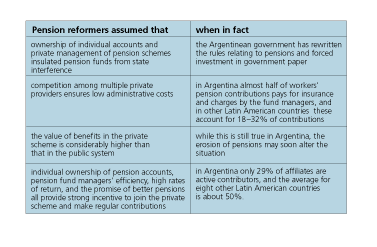
back
Some
related articles :
|
 |
Reforming the reform?
Towards recovery in Latin America
By: Carmelo Mesa-Lago
Insights 42, June 2002
One of the most painful consequences of Argentina's economic crisis has been the deterioration in its social security pensions. This has called into question some of the fundamental assumptions underlying two decades of pension reform in Latin America.
By the end of 2001, Argentina's 'privatised', fully funded pension scheme involved nine million individual accounts and had accumulated US$21,000 million - around 7% of the country's GDP. It was the largest pension fund in Latin America after Chile. The economic crisis in Argentina made the parity between the Argentinean peso (ARS) and the dollar unsustainable, and the government was forced to devalue the peso. The conversion of retirement accounts to pesos at the new exchange rate of ARS1.40 to $1 reduced their value by a staggering 29%.
The economic crisis has also affected the rates of return of the pension fund. The fund's yield in the past year was -9.8%, a full 17% less than the year before. Around 75% of the pension fund is invested in government debt, but following the crisis, the government cut interest rates paid on its debt to 7% in November 2001 and to 5.5% in March this year.
Softening the blow
In order to cushion the impact of the crisis on household income and to stimulate consumption, workers' pension contributions have been reduced from 11% of wages to 5%, but roughly half of contributions pay for insurance and charges by the private administrators. Out of 8.9 million workers affiliated to the system, only 2.6 million were contributing in February this year - and the proportion contributing was declining rapidly.
The trend of 'privatisation' of pensions in Latin America began with Chile in 1981, followed by 10 others: Peru (1993), Argentina and Colombia (1994), Uruguay (1996), Bolivia and Mexico (1997), El Salvador (1998), and Nicaragua, Costa Rica and the Dominican Republic (2001). Brazil, Honduras, Paraguay and Venezuela have either drawn up legal drafts or are currently debating reform.
Some of the assumptions underlying pension reform are being called into question by recent events in Argentina.

Reversion or reformation?
Once the Argentinean economy becomes more stable and is on a path to recovery, this should impact positively on the country's pension system - but some losses will inevitably be irreversible. Within Argentina the current crisis has provoked a heated debate about a 'reform of the reform'. Some argue for a return to the pay-as-you-go pension system which preceded recent reforms, but others argue for a revamping of the private system reinforcing its independence, improving competition, reducing costs, diversifying the portfolio and educating the insured on the culture of saving. Whatever the outcome of this debate, Argentina will be watched closely by Latin America as well as by other parts of the world where the 'Latin' model has influenced pension reform.
FAIR USE NOTICE: This
page contains copyrighted material the use of which has not been
specifically authorized by the copyright owner. Global Action on Aging
distributes this material without profit to those who have expressed a
prior interest in receiving the included information for research and
educational purposes. We believe this constitutes a fair use of any such
copyrighted material as provided for in 17 U.S.C § 107. If you wish to
use copyrighted material from this site for purposes of your own that go
beyond fair use, you must obtain permission from the copyright owner.
|

